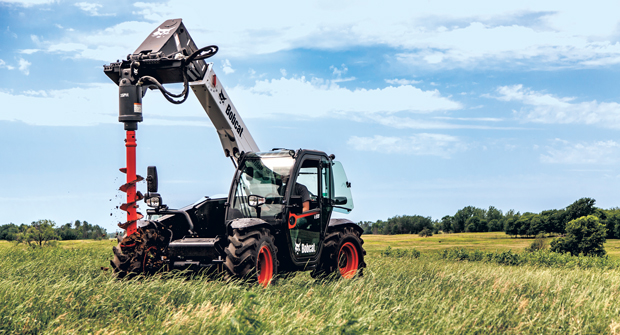
For landscape contractors, time saved on the job can be the difference between turning a profit or facing a loss. Stand-alone powered earth augers and drills or attachments for landscaping are key tools in improving efficiency and compensating for a lack of available labor on jobs.
Landscape augers and drills may be small enough to operate by hand, or large enough to work as attachments on loaders and excavators. Digging fence posts is a less intense production than setting footers for large decks or other structures, for example, but the right landscape augers can increase the efficiency of each.
LM spoke to Joe Haynes, president of Little Beaver; Lee Smith, attachments product manager at Bobcat; and Brandon King, product manager at Billy Goat, to review new products and best practices for landscapers looking to improve efficiency with earth augers and drills.
Saving labor to improve revenue
The difference between a profitable job and a money-loser often lies in the little things, such as a clean dispatch in the morning or avoiding damage to prevent costly callbacks. King says putting the right tools on the job site may be the best way to keep a job on track to hit its targeted hours.
“Using a powered auger saves time and labor and reduces fatigue for landscaping installs versus traditional shovel digging,” says King. “Powered augers generate high bit torque, which help break through tree roots, packed clay and small- to medium-sized rocks, which would otherwise have to be carved out by hand at a slow and painful pace.”
In addition to reducing handwork, powered augers can stand in for a fully-staffed crew. Haynes says Little Beaver designed its products for safe one-person operation, a key to working efficiently instead of having a larger crew.
“Our earth drills feature a patented steel torque tube, which transfers dangerous kickback to the engine carriage,” says Haynes. “Kickback can jar an operator’s body, causing strains and injuries. By protecting against kickback, the operator doesn’t need to work as hard to control the machine, which significantly reduces fatigue. This allows safe and productive one-man drilling.”
Range of applications
New equipment purchases can be a labor saver in the field, but they can also put a dent in owners’ wallets in the short term. Large equipment purchases are easiest to stomach when those machines can generate revenue throughout the season. For landscape augers and drills, contractors use specific drill bit setups for specific landscape applications.
“Knowing the ground conditions will ensure the proper bit is used,” says Smith. “The main difference between bits is the types of ground-engaging teeth. Operators want to match the correct bit to the ground condition, so they maximize the performance of the auger drive. Knowing the diameter and depth of the holes required can also help determine the bit and help with production.”
Selecting the right product comes down to knowing the project at hand.
“It is important to think about potential turf damage and repair requirements of the job,” says King. “Certain tracked machines with auger attachments can destroy turf compared to a self-propelled, one-man auger.”
Be prepared
Like all powered landscape equipment, these products can save time and labor but work best when crews observe proper safety practices.
“Always contact local utility companies before drilling to determine the exact location of underground services,” says Haynes. “Contractors should also look for earth drills that incorporate safety features.”
Features such as electric strike systems that can detect underground electrical lines help keep crews safe when operating the equipment.
Outside of the job, routine equipment maintenance ensures that equipment doesn’t spend large portions of the work season in the shop.
“It’s important to maintain your auger attachment to ensure optimal performance and safety,” says Smith. “Worn teeth or a rounded auger screw bit or tip can lead to ineffective or uneven holes being dug. Before each use, take time to check the condition of your attachment to keep it operating at its best.”

